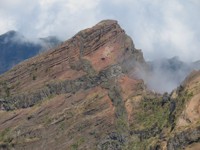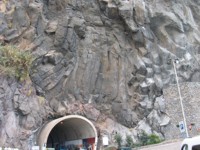- Trace Fossils of Ancient
Volcanoes -
Avencas Beach (Parede) - 8 October 2006, 10H00 to 12H00
This cache
is part of the 1st Annual International EarthCache
Day
When we speak of fossils the images that
immediately come to mind are the skeletal remains of the large
quadrupeds that once roamed the earth back in the Triassic (245 Ma)
– Cretaceous (65 Ma) periods.
No doubt, “trace fossils” will conjure up visions of the king of
the Cretaceous period and Jurassic Park. However, trace fossils can
be more subtle, smaller and you can be walking right over them
without ever being aware of their existence.
Ancient and present day volcanoes are features that have left a
definite fingerprint on the surface of the earth. The present day
eruptions that we are presented with on the
 news bulletins of our global television
coverage are perhaps the best known. The latest major eruption
(at the time this cache went to press) was the August the 16th
eruption of Tungarahua volcano in central Ecuador. However,
the USGS Weekly Volcanic Activity Report keeps
track of dozens of potentially hazardous and deadly volcanic
activity throughout the world.
news bulletins of our global television
coverage are perhaps the best known. The latest major eruption
(at the time this cache went to press) was the August the 16th
eruption of Tungarahua volcano in central Ecuador. However,
the USGS Weekly Volcanic Activity Report keeps
track of dozens of potentially hazardous and deadly volcanic
activity throughout the world.
Less hazardous and clearly harmless clues of this activity have
been left as fossils for geologists to study and for the
public in general to marvel at. These fingerprints are dykes,
sills, volcanic chimneys and basalt flows (columnar and pillow)
left exposed as a result of natural erosion processes, excavations,
archaeological digs and mining.
In Portugal we have several examples of these types of volcanic
fingerprints. Here are but a few listed:
- Dykes: Commonly found in several settings and
common occurrences along the coastline where exposure is perhaps
best.
 These are bodies of lava that cut across the
bedding of the rock.
These are bodies of lava that cut across the
bedding of the rock.
- Sills: Commonly found in several settings and
common occurrences along the coastline where exposure is perhaps
best. These are bodies of lava that are parallel to the bedding of
the rock.
- Volcanic chimneys: Commonly found in the
Lisbon area. These are remnants of the conduits of the lava to the
surface. Clear and simple examples can be found at Cabeço de
Montachique, where there are two caches nearby, 1-
Passeio pelo Parque de Montachique and 2 –
Sanatório Albergaria and at
Les Aventures de Tintin to name but a few
clear examples.
Basalt flows:
- Columnar basalts: An example of this type of
basalt can be seen at another earthcache created in Portugal by our
friend
Lynx pardinus. His cache at
Penedo do Lexim is an excellent opportunuty
to view examples of this type of basalt and well worth a
 visit. It forms during the cooling of a thick
lava flow, contractional joints or fractures form. If a flow
cools relatively rapidly, significant contraction forces build
up. While a flow can shrink in the vertical dimension without
fracturing, it cannot easily accommodate shrinking in the
horizontal direction unless cracks form. The extensive
fracture network that develops results in the formation of
columns. Because hexagons fit together efficiently with no
vacant space (a tessellation), this is the most common pattern
that develops. Pentagonal, heptagonal or octagonal joint
patterns are also known, but are less common. Note that the
size of the columns depends loosely on the rate of cooling;
very rapid cooling may result in very small (<1 cm
diameter) columns, and vice versa.
visit. It forms during the cooling of a thick
lava flow, contractional joints or fractures form. If a flow
cools relatively rapidly, significant contraction forces build
up. While a flow can shrink in the vertical dimension without
fracturing, it cannot easily accommodate shrinking in the
horizontal direction unless cracks form. The extensive
fracture network that develops results in the formation of
columns. Because hexagons fit together efficiently with no
vacant space (a tessellation), this is the most common pattern
that develops. Pentagonal, heptagonal or octagonal joint
patterns are also known, but are less common. Note that the
size of the columns depends loosely on the rate of cooling;
very rapid cooling may result in very small (<1 cm
diameter) columns, and vice versa.
- Pillow basalts: Spectacular examples of this
type of flow are present in Caniçal (Madeira). When basalt erupts
 underwater or flows into the sea, the cold
water quenches the surface and the lava forms a distinctive
pillow shape, through which the hot lava breaks to
form another pillow. This pillow texture is very
common in underwater basaltic flows and is diagnostic of an
underwater eruption environment when found in ancient rocks.
Pillows typically consist of a fine-grained core with a glassy
crust and have radial jointing. Size of individual pillows can
vary from 10 cm up to several metres.
underwater or flows into the sea, the cold
water quenches the surface and the lava forms a distinctive
pillow shape, through which the hot lava breaks to
form another pillow. This pillow texture is very
common in underwater basaltic flows and is diagnostic of an
underwater eruption environment when found in ancient rocks.
Pillows typically consist of a fine-grained core with a glassy
crust and have radial jointing. Size of individual pillows can
vary from 10 cm up to several metres.
The cache:
If you're interested in learning a little more about the planet
you live in, then let’s meet on the 8th of October for an on-site
description and open air informal lecture on
dykes and sills at Praia das Avencas
(Parede) at the above coordinates. At 10H00, the prediction is
for a low tide that will allow clear viewing of these features.
On hand will also be a biologist that will try to answer any
questions you may have regarding the diverse biota that live
amongst these rocks.
The nearby beach will allow, the weather permitting in October,
for a relaxed atmosphere and the more restless can brave the cooler
water temperatures of the Atlantic ocean.
For more instructions of how to get to the location, please follow
the instructions
here. It will also give you a chance to
brush up on the features you will observe
I support earthcaching!
